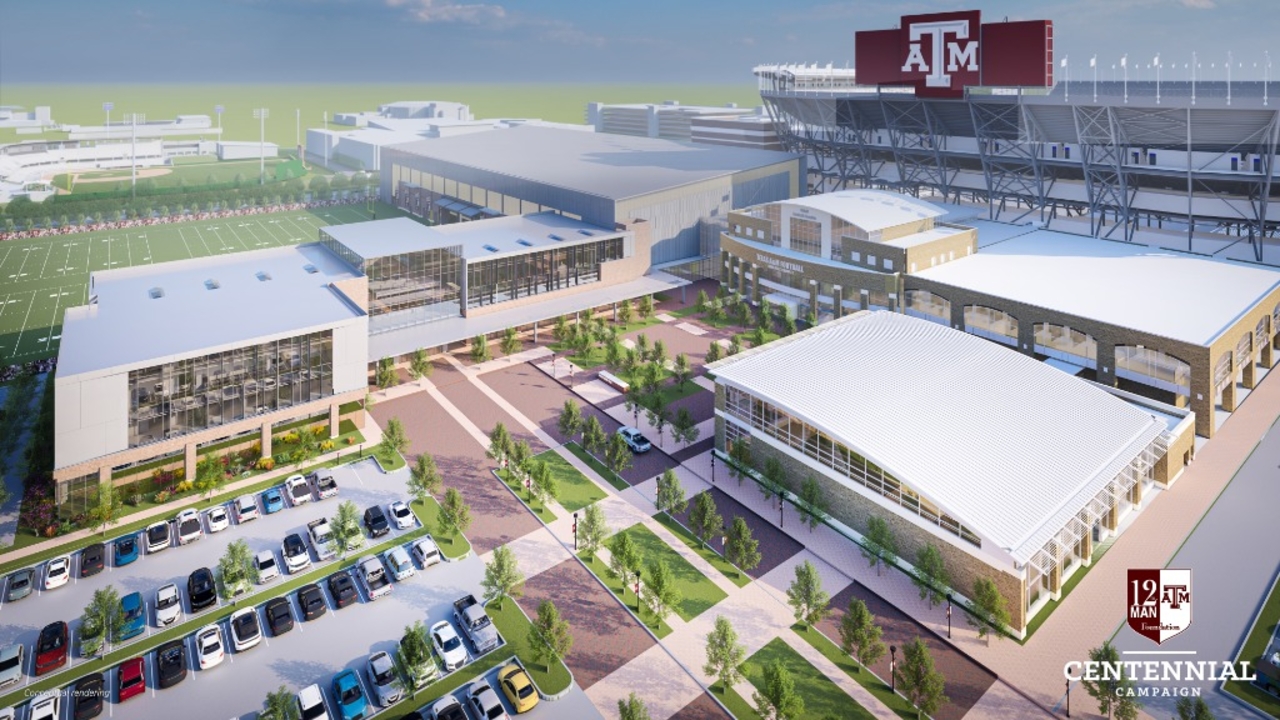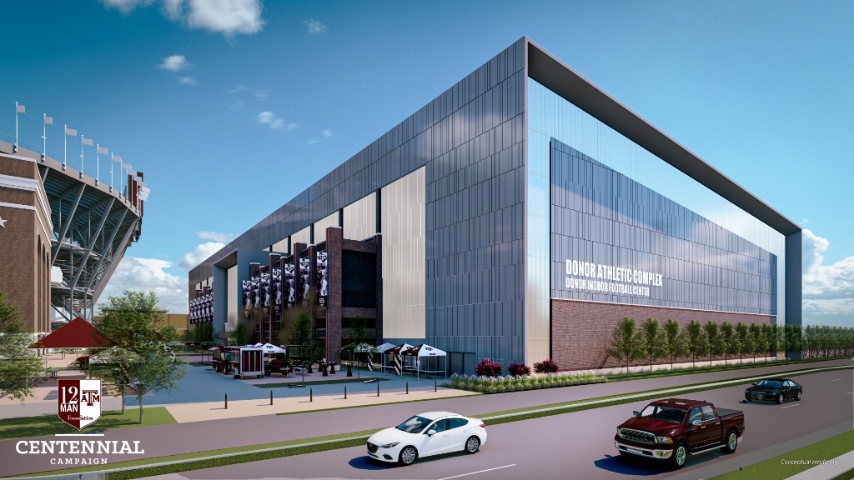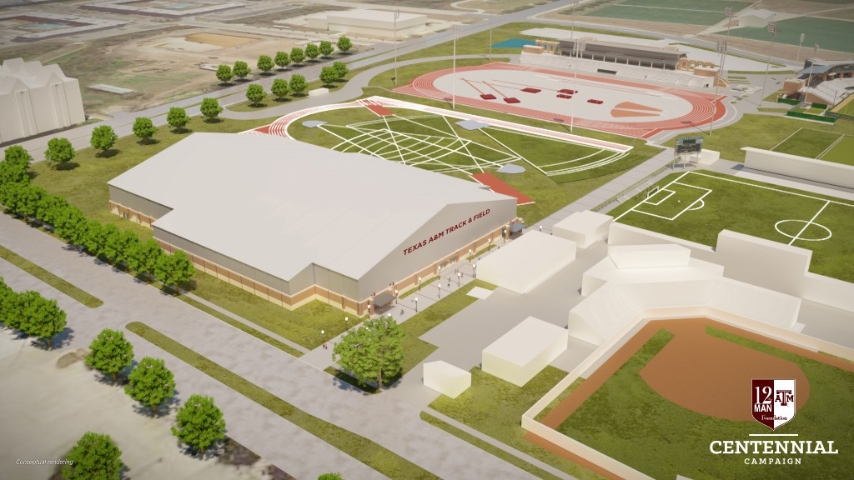But with tennis, let's not spend money and use a corporate indoor tennis facility 10-15 minutes away instead of right behind the current outdoor tennis facility, where there was room left for indoors. Makes perfect sense.

Centennial Campaign poised to yield big results for Texas A&M Athletics
For about a decade, Texas A&M has flexed Hulk Hogan-like biceps in the college football facilities arms race.
But with the $120 million Centennial Campaign, A&M is going full-blown “The Rock.”
The Centennial Campaign, which already has raised $88 million, will fund the construction of a state-of-the-art indoor football practice facility, an indoor track stadium, a football academic and wellness center as well as renovations to the Bright Football Complex.
Myles Garrett wants even more sacks. Elon Musk wants even more money. Usain Bolt wants even faster times.
Texas A&M wants its incredible facilities to be even better.
“We’re not going to stand still,” Texas A&M Director of Athletics Ross Bjork said last week. “If you maintain, you fall behind. It’s as simple as that.”
You know the history. A&M’s football program was at an elite level in the ‘90s. Then, Texas, Oklahoma and LSU — primary regional recruiting rivals — hired new coaches and ponied up the money to upgrade facilities.
Meanwhile, A&M stood pat. Recruiting gradually eroded. On-field success declined.
Finally, then-coach R.C. Slocum approached former players and A&M benefactor Bum Bright to jumpstart funding for what is now the Bright Complex.
After the move to the Southeastern Conference in 2012, A&M made the commitment to building facilities as stellar or better than any other in the nation.
However, Bjork is adamant the Centennial Campaign isn’t a matter of keeping up with the Joneses, surpassing the Joneses, or even becoming the Joneses.
He said only 20 percent of the project is for aesthetics. The other 80 percent is out of need.
The eyesore that is the current indoor football practice facility is too small and costly to maintain.
Also, the football program — with more analysts and recruiting personnel — is outgrowing the Bright Center.
"Football staffs have grown,” Bjork said. “We have recruiting operations people. We have analysts tucked away in closets and nooks and crannies.”

And the indoor track stadium … well, doesn’t it make sense to relocate it next to outdoor E.B. Cushing Stadium?
“We have football facilities that are disjointed right now,” Bjork said. “We have some of our student-athlete services facilities that are disjointed. So, consolidation was a big part of (The Centennial Campaign).
“Let’s have football all with football. Let’s have academics all with academics. Let’s have nutrition near academics. Let’s have track with track. Let’s create a track complex.”
The indoor football structure and the renovation of the Bright Complex are planned to be completed by August of 2023. The indoor track stadium should be completed by the fall of ’23. The Academics and Wellness Center is scheduled to be finished by the fall of ’24.
After these projects, improvements for soccer and Blue Bell Park are expected.
Bjork believes baseball can be a revenue-producing sport. Expanding 7,000-seat Blue Bell Park can make that happen.
“We need more seating, better seating, premium seating and outfield seating,” Bjork said. “And we need things for players: batting cages, pitching labs, locker room, a players lounge.”
Bjork said basketball will eventually be addressed, too. A study will be conducted to determine whether renovating Reed Arena or building a new structure would be the most cost-effective.

Bjork is fortunate that he has a generous fan base that’s willing to help fund these projects.
“We have amazing donors,” he said. “Just like anybody, they want to know what the vision is. ‘How will this benefit the program? What does the future of college athletics look like?’ Once we laid all that out, people got on board with the vision.
“People saw what happened when the SEC transition happened and when Kyle Field was redeveloped. This is the next phase. We’ve done great and we have a ton of momentum, but what’s next?
“People say they like that vision and ‘I want to help.”’
Of course, what most long-suffering Aggies really want is to help A&M win a football national championship.
That’s why A&M already raised about three-fourths of its $120 million goal when the Centennial Campaign was unveiled just two weeks ago.
But even the generosity of Aggies could be limited, right?
All the sports want or need improvements. Also, boosters all over the country are now contributing to “collectives” that help fund NIL deals for athletes at their programs.
A donor may have to choose whether to fund NIL deals, buildings or scholarships.
“It’s their money,” Bjork said. “We know NIL is out there. We know people want to give to campaigns. We know people still want to buy tickets and support our programs. We know people still want to buy sponsorships.
“So far, we have not seen people choose one to the detriment of the other.”
That’s probably because of the lessons learned from past mistakes.
Alabama will continue to invest in its program. So will LSU. So will Texas and Oklahoma, which will enter the Southeastern Conference in 2025.
“You always pay attention to what the competition is doing,” Bjork said. “People are not sitting still in our conference. People are not sitting still in our state. We want to be at the forefront.”
Or as the big-bicep guys flexing in the gym say: "You're either getting better or you're getting worse."

